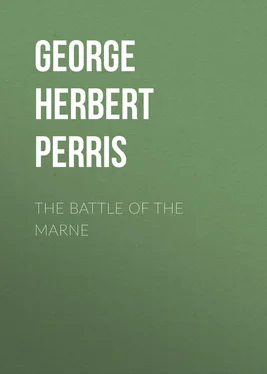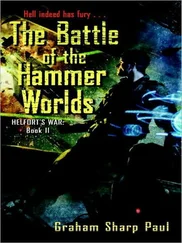George Herbert Perris - The Battle of the Marne
Здесь есть возможность читать онлайн «George Herbert Perris - The Battle of the Marne» — ознакомительный отрывок электронной книги совершенно бесплатно, а после прочтения отрывка купить полную версию. В некоторых случаях можно слушать аудио, скачать через торрент в формате fb2 и присутствует краткое содержание. Жанр: foreign_prose, foreign_antique, на английском языке. Описание произведения, (предисловие) а так же отзывы посетителей доступны на портале библиотеки ЛибКат.
- Название:The Battle of the Marne
- Автор:
- Жанр:
- Год:неизвестен
- ISBN:нет данных
- Рейтинг книги:5 / 5. Голосов: 1
-
Избранное:Добавить в избранное
- Отзывы:
-
Ваша оценка:
- 100
- 1
- 2
- 3
- 4
- 5
The Battle of the Marne: краткое содержание, описание и аннотация
Предлагаем к чтению аннотацию, описание, краткое содержание или предисловие (зависит от того, что написал сам автор книги «The Battle of the Marne»). Если вы не нашли необходимую информацию о книге — напишите в комментариях, мы постараемся отыскать её.
The Battle of the Marne — читать онлайн ознакомительный отрывок
Ниже представлен текст книги, разбитый по страницам. Система сохранения места последней прочитанной страницы, позволяет с удобством читать онлайн бесплатно книгу «The Battle of the Marne», без необходимости каждый раз заново искать на чём Вы остановились. Поставьте закладку, и сможете в любой момент перейти на страницу, на которой закончили чтение.
Интервал:
Закладка:
24
Speaking of the attack of the 20th Division (10th Corps) at Tamines, M. Hanotaux ( Histoire , vol. v. p. 278) says it advanced with feverish ardour only to fall upon solidly held defences. “Our officers had always been told that, on condition of attacking resolutely and without hesitation, they would surprise the enemy and easily dispose of them. But the Germans everywhere awaited them firmly on solid positions flanked with innumerable machine-guns, before which most of our men fell.” Of the “insensate immolation” of the 3rd Corps at Chatelet, M. Engerand says: “Without artillery preparation, and knowing that they were going to a certain death, these picked troops threw themselves on the enemy infantry, solidly entrenched on the edge of the town; in a quarter of an hour a half of their effectives had fallen.” He adds that the upper command of the Corps was relieved the same evening.
25
“It was expected that the British Army would take its place on the 20th, but it arrived only on the 22nd. On the 20th, it was still far behind in the region of Le Nouvion–Wassigny–Le Cateau. If it had been in place on the 20th, the Allied Army would have found itself constituted at the very moment when the Germans entered Brussels.” This last phrase is at least singularly ambiguous: Von Bülow was not in Brussels, but only a day’s march from the Sambre, on the 20th. But, if the British had then been at Mons, the Allied Army would not have been “constituted,” for Lanrezac’s forces were far from being all in place on that day. “It is true,” said M. Hanotaux a little later, “that the French Army was not all in place on the 22nd , and that the Territorial divisions were in rather mediocre conditions as to armament and encadrement ” ( L’Enigme de Charleroi , p. 52). It is Bülow’s appearance on the Sambre a day before Lanrezac was ready that makes the French historian credit the enemy with “the principal advantage, the initiative.”
26
Four years passed ere a detailed account of the defence and fall of Maubeuge was published ( La Verité sur le Siège de Maubeuge , by Commandant Paul Cassou, of the 4th Zouaves. Paris: Berger-Levrault). There are, in the case of this fortress, points of likeness to and of difference from that of Lille. In June 1910 the Ministry of War had decided that Maubeuge should be regarded as only a position of arrest, not capable of sustaining a long siege; and in 1913 the Superior War Council decreed that it should be considered only as a support to a neighbouring field army. It then consisted of an enceinte dating from Vauban, dominated by an outer belt of six main forts and six intermediate works about twenty years old, furnished with 335 cannon, none of which carried more than 6 miles. The garrison consisted of an infantry regiment, three reserve and six Territorial regiments. In the three weeks before the siege began, 30,000 men were engaged in digging trenches, laying down barbed wire, and making other defences.
The siege was begun by the VII Reserve Corps, a cavalry brigade, and a division from another corps, about 60,000 men, on August 25. On that and two following days effective sorties were made. On the 29th the bombardment began. One by one the forts were smashed by heavy guns and mortars, including 420 mm. pieces throwing shells of nearly a ton weight, firing from the safe distance of 9 or 10 miles. On September 1, all the troops available made a sortie, and a regular battle was fought. Some detachments reached within 250 yards of the German batteries, only to be mown down by machine-gun fire. After this two German attacks were repulsed. On September 5, however, the enemy got within the French lines, and on the 7th the place had become indefensible. At 6 p.m. the capitulation was signified, and on September 8, at noon, the garrison surrendered, General von Zwehl saying to General Fournier: “You have defended the place with a rare vigour and much resolution, but the war has turned against you.” The German Command afterward claimed to have taken at Maubeuge 40,000 prisoners, 400 guns, and a large quantity of war material.
27
Statement of M. Messimy before the Commission of Inquiry on Metallurgy, May 30, 1919, reported in the Paris Press the following day. In his evidence, M. Messimy blamed Joffre for not having been willing, in August 1914, to recognise the danger on the side of Belgium. Undoubtedly, he added, it was a fault of the French Command in 1912 and 1913 not to contemplate the prompt use of reserves, and to fall back on the Three Years’ Service law, “which no one would defend to-day.” M. Messimy argued that the doctrine of the offensive à outrance was common to the French and German Armies, and was at that time universal in military circles.
Joffre, Première Crise du Commandement , by Mermeix (Paris: Ollendorff. 1919), is a careful and unprejudiced study of the changes, ideas, and personal antagonisms in the French Army Commands during the first period of the war. It concludes with a section in which “Attacks upon Joffre” and “Explanations collected at the G.Q.G.,” are set forth on opposite pages.
28
See note at top of p. 249.
29
G. Blanchon, Le General Joffre , Pages Actuelles, 1914–5, No. 11 (Paris: Bloud et Gay).
30
M. Arthur Huc, editor of the Dépêche de Toulouse , in which journal the interview was printed, March 1915.
31
Statement by General Messimy at the Commission of Inquiry on Metallurgy, April 28, 1919.
32
For details, see Hanotaux, “La Bataille de la Trouée de Charmes,” Rev. des Deux Mondes , November 15, 1916; Engerand, loc. cit. ; a vindication of General Dubail, by “Cdt. G. V.”: “La 1re Armée et la Bataille de la Trouée de Charmes,” La Revue , January 1, 1917; Barrés: “Comment la Lorraine fut Sauvée,” Echo de Paris , September 1917.
33
See p. 34. The mismanagement of this battle was the subject of evidence at the Metallurgical Commission of Inquiry on May 15, 1919.
34
Miles, Le General Maunoury , Pages Actuelles, No. 49.
Интервал:
Закладка:
Похожие книги на «The Battle of the Marne»
Представляем Вашему вниманию похожие книги на «The Battle of the Marne» списком для выбора. Мы отобрали схожую по названию и смыслу литературу в надежде предоставить читателям больше вариантов отыскать новые, интересные, ещё непрочитанные произведения.
Обсуждение, отзывы о книге «The Battle of the Marne» и просто собственные мнения читателей. Оставьте ваши комментарии, напишите, что Вы думаете о произведении, его смысле или главных героях. Укажите что конкретно понравилось, а что нет, и почему Вы так считаете.










